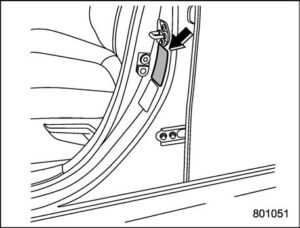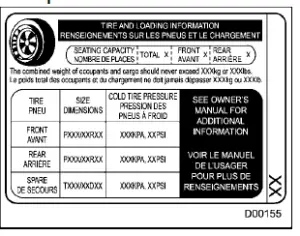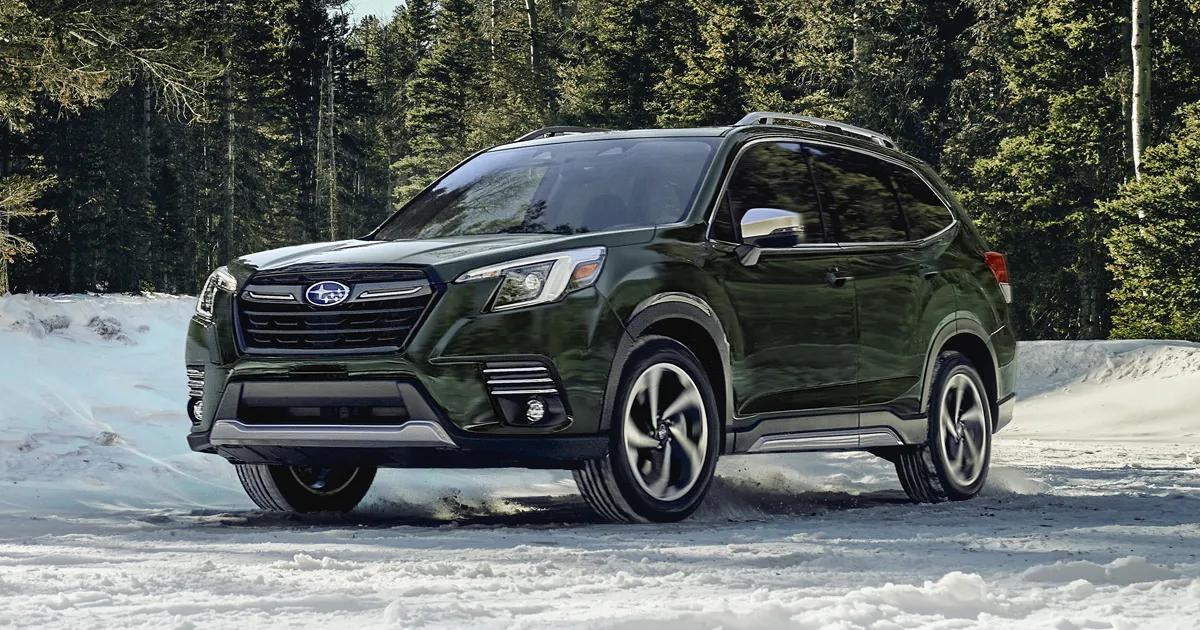Subaru Forester 2023 Uniform Tire Quality Grading Standards Base
The premium tires that come with the 2023 Subaru Forester are made to offer a harmonious blend of performance, longevity, and safety. Subaru works with reliable tire producers to guarantee that the tires on the Forester match the requirements and performance benchmarks of the car. The Forester is ideally suited for a variety of driving situations because these tires are designed to offer outstanding traction in a range of road conditions, including wet and snowy ones. In addition to improving fuel efficiency, their composition and design provide a smooth and steady ride. The Forester’s tires are essential to providing a safe and dependable driving experience, whether you’re traveling off-road or through city streets.
2023 Subaru Forester Specs, Price, Features, Mileage (Brochure)
Uniform Tire Quality Grading (UTQG)
Vehicle placard

The vehicle placard is attached to the driver’s side door pillar.
Example:

The vehicle placard shows the original tire size, recommended cold tire inflation pressure on each tire at maximum loaded vehicle weight, seating capacity, and loading information
Adverse safety consequences of underinflation
Driving at high speeds with excessively low tire pressures can cause the tires to flex severely and to rapidly become hot. A sharp increase in temperature could cause tread separation, and failure of the tire(s). A possible resulting loss of vehicle control could lead to an accident.
Measuring and adjusting air pressure to achieve proper inflation
Check and, if necessary, adjust the pressure of each tire (including the spare) at least once a month and before any long journey. Check the tire pressures when the tires are cold. Use a pressure gauge to adjust the tire pressures to the specific values. Driving even a short distance warms up the tires and increases the tire pressures. Also, the tire pressures are affected by the outside temperature. It is best to check tire pressure outdoors before driving the vehicle. When a tire becomes warm, the air inside it expands, causing the tire pressure to increase. Be careful not to mistakenly release air from a warm tire to reduce its pressure.
Glossary of tire terminology
Accessory weight
The combined weight (in excess of those standard items that may be replaced) of the automatic transmission, power steering, power brakes, power windows, power seats, radio, and heater, to the extent that these items are available as factory-in-stalled equipment (whether installed or not).
Bead
The part of the tire that is made of 512 Tire information steel wires, wrapped or reinforced by ply cords, and that is shaped to fit the rim.
- Bead separation
A breakdown of the bond between components in the bead. - A bias ply tire
A pneumatic tire in which the ply cords that extend to the beads are laid at alternate angles substantially less than 90 degrees to the center-line of the tread. - Carcass
The tire structure, except tread and sidewall rubber which, when inflated, bears the load. - Chunking
The breaking away of pieces of the tread or sidewall. - Cold tire pressure
The pressure in a tire that has been driven less than 1 mile or has been standing for three hours or more.
Cord
The strands form the plies in the tire.
Cord separation
The parting of cords from adjacent rubber compounds.
Cracking
Any parting within the tread, side wall, or inner liner of the tire extending to cord material.
Curb weight
The weight of a motor vehicle with standard equipment including the maximum capacity of fuel, oil, and coolant, and if so equipped, air conditioning, and additional weight optional engine.
Extra load tire
A tire is designed to operate at higher loads and higher inflation pressure than the corresponding standard tire.
Groove
The space between two adjacent tread ribs.
Inner liner
The layer(s) forming the inside surface of a tubeless tire that contains the inflating medium within the tire.
Inner liner separation
The parting of the inner liner from cord material in the carcass.
Intended outboard sidewall
The sidewall that contains a whitewall, bears white lettering or bears manufacturer, brand, and/or model name molding that is higher or deeper than the same molding on the other sidewall of the tire, or The outward-facing sidewall of an asymmetrical tire that has a particular side that must always face outward when mounting on a vehicle.
Light truck (LT) tire
A tire is designated by its manufacturer as primarily intended for use on lightweight trucks or multipurpose passenger vehicles.
Load rating
The maximum load that a tire is rated to carry for a given inflation pressure.
Maximum inflation pressure
The maximum cold inflation pressure to which a tire may be inflated.
Maximum load rating
The load rating for a tire at the maximum permissible inflation pressure for that tire.
Maximum loaded vehicle weight
The sum of
- Curb weight
- Accessory weight
- Vehicle capacity weight
- Production options weight
Maximum permissible inflation pressure
The maximum cold inflation pressure to which a tire may be inflated.
Measuring rim
The rim on which a tire is fitted for physical dimension requirements.
Normal occupant weight
150 lbs (68 kg) times the number of occupants specified in the second column of Table 1 is appended to the end of this section. Occupant distribution Distribution of occupants in a vehicle as specified in the third column of Table 1 is appended to the end of this section.
Open splice
Any parting at any junction of tread, sidewall, or inner liner that extends to cord material.
Outer diameter
The overall diameter of an inflated new tire.
Overall width
The linear distance between the exteriors of the sidewalls of an inflated tire, including elevations due to labeling, decorations, or protective bands or ribs.
Passenger car tire
A tire intended for use on passenger cars, multipurpose passenger vehicles, and trucks, that have a gross vehicle weight rating (GVWR) of 10,000 l bs (4,535 kg) or less. . Ply A layer of rubber-coated parallel cords.
Ply separation
A parting of rubber compound between adjacent plies.
Pneumatic tire
A mechanical device made of rubber, chemicals, fabric and steel or other materials, that, when mounted on an automotive wheel, provides traction and contains the gas or fluid that sustains the load. Production options weight The combined weight of those installed regular production options weighing over 5.1 l bs (2.3 kg) in excess of those standard items which they replace, not previously considered in curb weight or accessory weight, including heavy duty brakes, ride levelers, roof rack, heavy-duty battery, and special trim. . Radial ply tire
A pneumatic tire in which the ply cords that extend to the beads are laid at substantially 90 degrees to the centerline of the tread.
- Recommended inflation pressure
- The cold inflation pressure recom
- 514 Tire information mended by a vehicle manufacturer. .
Reinforced tire
A tire is designed to operate at higher loads and at higher inflation pressures than the corresponding standard tire.
Rim
A metal support for a tire or a tire and tube assembly upon which the tire beads are seated
Rim diameter
Nominal diameter of the bead seat. . Rim size designation
Rim diameter and width.
Rim type designation
The industry of manufacturer’s designation for a rim by style or code. . Rim width
Nominal distance between rim flanges.
Section width
The linear distance between the exteriors of the sidewalls of an inflated tire, excluding elevations due to labeling, decoration, or protective bands.
Sidewall
That portion of a tire between the tread and bead.
Sidewall separation
The parting of the rubber compound from the cord material in the side wall.
Snow tire
A tire that attains a traction index equal to or greater than 110, compared to the ASTM E-1136-93 Standard Reference Test Tire, when using the snow traction test as described in ASTM F-1805-00, Standard Test Method for Single Wheel Driving Traction in a Straight Line on Snow-and Ice-Covered Surfaces and that is marked with an Alpine Symbol “ ” on at least one sidewall.
Test rim
The rim on which a tire is fitted for testing, and it may be any rim listed as appropriate for use with that tire. Tread That portion of a tire that comes into contact with the road.
Tread rib
A tread section running circumferentially around a tire.
Tread separation
Pulling away of the tread from the tire carcass.
Treadwear indicators (TWI)
The projections within the principal grooves are designed to give a visual indication of the degrees of wear of the tread.
Vehicle capacity weight
The rated cargo and luggage load plus 150 lbs (68 kg) times the vehicle’s designated seating capacity.
Vehicle maximum load on the tire Load
on an individual tire that is determined by distributing to each axle its share of the maximum loaded vehicle weight and dividing by two.
Vehicle normal load on the tire
Load on an individual tire that is determined by distributing to each axle its share of the curb weight, accessory weight, and normal occupant weight (distributed in accordance with Table 1 which is appended to the end of this section) and dividing by 2.
Wheel-holding fixture
The fixture was used to hold the wheel and tire assembly securely during testing.
| Designated seating capacity, number of occupants | Vehicle normal load, number of occupants | Occupant distribution in a normally loaded vehicle |
| 2 through 4 | 2 | 2 in front. |
| 5 through 10 | 3 | 2 in front, 1 in second seat. |
|
11 through 15 |
5 |
2 in front, 1 in second seat, 1 in third seat, 1 in fourth seat. |
|
16 through 22 |
7 |
2 in front, 2 in second seat, 2 in third seat, 1 in fourth seat. |
Tire care maintenance and safety practices
- Check on a daily basis that the tires are free from serious damage, nails, and stones. At the same time, check the tires for abnormal wear.
- Inspect the tire tread regularly and replace the tires before their tread wear indicators become visible. When a tire’s tread wear
indicator becomes visible, the tire is worn beyond the acceptable limit and must be replaced immediately. With a tire in this condition, driving at even low speeds in wet weather can cause the vehicle to hydroplane. The possible resulting loss of vehicle control can lead to an accident. - To maximize the life of each tire and ensure that the tires wear uniformly, it is best to rotate the tires every 6,000 miles (10,000 km). Replace any damaged or unevenly worn tires at the time of rotation. After tire rotation, adjust the tire pressures and make sure the wheel nuts are correctly tightened.
Determining compatibility of tire and vehicle load capacities
The sum of four tires’ maximum load ratings must exceed the maximum loaded vehicle weight (“GVWR”). In addition, the sum of the maximum load ratings of two front tires and of two rear tires must exceed each axle’s maximum loaded capacity (“GAWR”). Original equipment tires are designed to fulfill those conditions. The maximum loaded vehicle weight is referred to as the Gross Vehicle Weight Rating (GVWR). Each axle’s maximum loaded capacity is referred to as Gross Axle Weight Rating (GAWR). The GVWR and each axle’s GAWR are shown on the vehicle certification label located at the bottom of the driver’s side door pillar. The GVWR and front and rear GAWRs are determined by not only the maximum load rating of tires but also the loaded capacities of the vehicle’s suspension, axles, and other parts of the body. Therefore, this means that the vehicle cannot necessarily be loaded up to the tire’s maximum load rating on the tire sidewall.
Adverse safety consequences of overloading on handling and stopping on tires
Overloading could affect vehicle handling, stopping distance, and vehicle and tire performance in the following ways. This could lead to an accident and possibly result in severe personal injury.
- Vehicle stability will deteriorate.
- Heavy and/or high-mounted loads could increase the risk of rollover.
- Stopping distance will increase.
- Brakes could overheat and fail.
- Suspension, bearings, axles and other body parts could break or experience accelerated wear that will shorten vehicle life.
- Tires could fail.
- Tread separation could occur.
- Tire could separate from its rim.
Steps for Determining Correct Load Limit
- Locate the statement “The combined weight of occupants and cargo should never exceed XXX kg or XXX lbs.” on your vehicle’s placard.
- Determine the combined weight of the driver and passengers that will be riding in your vehicle.
- Subtract the combined weight of the driver and passengers from XXX kg or XXX lbs.
- The resulting figure equals the available amount of cargo and luggage load capacity. For example, if the “XXX” amount equals 1,400 lbs. and there will be five 150 l b passengers in your vehicle, the amount of available cargo and luggage load capacity is 650 lbs. (1,400 − 750 (5 6 150) = 650 lbs.)
- Determine the combined weight of luggage and cargo being loaded on the vehicle. That weight may not safely exceed the available cargo and luggage load capacity calculated in Step 4.
- If your vehicle will be towing a trailer, load from your trailer will be transferred to your vehicle. Consult this manual to determine how this reduces the available cargo and luggage load capacity of your vehicle.
FAQ
The specific tire type may vary depending on the trim level and configuration, but the Forester typically comes with all-season tires as standard.
Yes, the Forester’s tires are designed to provide traction and performance in a variety of driving conditions, including both on-road and off-road situations.
The tire sizes for the Forester can vary depending on the trim level and configuration, but common sizes range from 17 to 18 inches in diameter.
Subaru may collaborate with various reputable tire manufacturers, and the specific brand of OEM tires can vary.
Yes, you have the flexibility to choose different tires, but it’s important to select tires that meet Subaru’s specifications and are compatible with the Forester’s design.
Tread warranties for the Forester’s tires can vary depending on the tire manufacturer and specific tire model. Check with the manufacturer or dealer for warranty details.
While all-season tires on the Forester offer good performance in winter conditions, some drivers in areas with severe winters may opt for winter-specific tires for enhanced traction.
You can often upgrade to larger or performance-oriented tires, but ensure that the selected tires are compatible with the vehicle’s specifications and do not affect its handling or safety negatively.
Regular tire maintenance includes checking tire pressure, rotating the tires, and inspecting for signs of wear. Follow the maintenance schedule outlined in the owner’s manual.
Yes, tire quality and condition can impact fuel efficiency. Properly inflated and well-maintained tires can contribute to better fuel economy.
It’s recommended to check tire pressure at least once a month and before long trips. Refer to the owner’s manual for the recommended tire pressure.
The recommended tire pressure can vary depending on the specific tire size and trim level. You can find the correct tire pressure specifications on the driver’s side door jamb or in the owner’s manual.
Minor tire punctures or damage can often be repaired by a professional tire technician. However, it depends on the extent and location of the damage.
The Forester may come equipped with tire pressure monitoring systems (TPMS) that alert you if tire pressure is too low, enhancing safety.
To extend tire life, maintain proper tire pressure, rotate the tires regularly, avoid aggressive driving habits, and have the alignment checked when necessary.
Useful Link
View Full User Guide: Subaru Forester 2023 Base User Guide
Download Manuals: https://www.subaru.com/owners/vehicle-resources/manuals.html
2023 Subaro Forester Specs, Price, Features, Mileage (Brochure)


